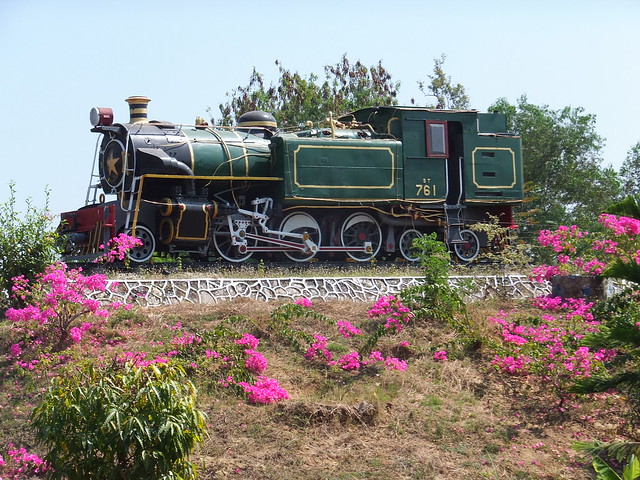skip to main |
skip to sidebar
Events of Saturday 26th April 2014
Click on any picture below for an uncropped image.
I spent Friday night in the Guest Room at Dr. Hla Tun’s house in Yangon. In a ‘Western style’ bed I started to catch up on sleep but still had to get up at 04:45 on Saturday because the Doctor and I were flying to Nyaung Oo to get to the Bagan Clinic. The Doctor’s charming wife had specially prepared oatmeal for my breakfast (my intolerance to even mildly spicy food is becoming well-known).
Around 05:20, I think, we set off by car, with the Doctor driving (together with his son, presumably to return the car after we’d left). At the Domestic Terminal, we were quickly checked-in for our flight by small turbo-prop to Nyaung Oo. I didn’t spot a single computer but the system usually works smoothly (albeit with a lot of manual checking and note-writing). Since this is the hot season, I was quite surprised to see that a lot of our passengers were European or Japanese tourists together with their guides. A few minutes later, we were shepherded to a waiting bus for a transfer of only a few yards to our waiting aircraft. Deparure time was 07:20 but, as has happened before, we were airborne before 07:10. The flight took around 75 minutes, in which time the friendly cabin crew had distributed daily newspapers, a pre-packed sandwich breakfast and hot and cold drinks.
Once landed, we disembarked, leaving passengers who were destined for Mandalay and Heho on board. No carousel, no belts, but the checked baggage very quickly arrived.
The Bagan Monastery ‘People Carrier’ was waiting to take us to the clinic. On the way, we paused at a tea shop in the town for the inevitable Sweet Tea before continuing past various 1000-year old temples to our destination.
On our arrival, the elderly Head Monk was waiting to greet us. The Clinic is on Monastic land and the active support of the Head Monk is essential.
When I first visited Bagan in 2008, there was no clinic in the dusty monastery compound. I became involved in the vision of the Head Monk and Doctor Hla Tun to provide a Free Medical Clinic for the people of this rural area. The original clinic building opened for business in 2011 and I attended the official opening ceremony on 30th October 2011 (Opening of the Bagan Medical Clinic). I'd certainly not realised the scale of demand which would be unleashed and there are a series of posts (Medical Support in Burma) showing just how many patients arrive on clinic days, sometimes travelling huge distances to seek affordable health care.
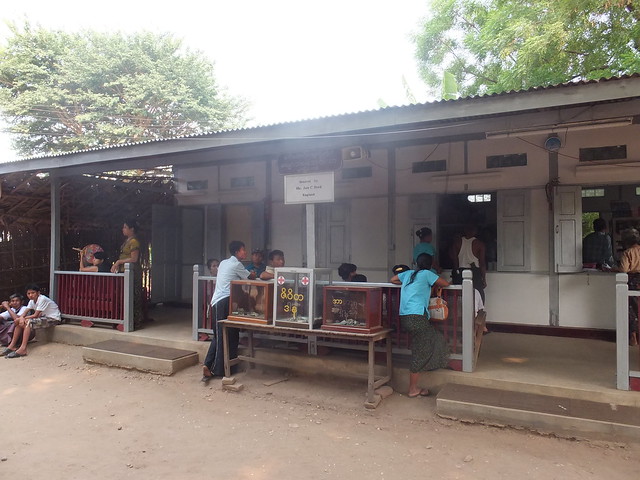 The original Clinic Building, formally opened on 30th October 2011, remains in use for consultations and dispensing medication.
The original Clinic Building, formally opened on 30th October 2011, remains in use for consultations and dispensing medication.
As the clinic became better known, local and overseas donors have provided further support and I was impressed to see the New Clinic Building which has been built a few yards away from the first building. This building was brought into use in February 2014 as a temporary Physiotherapy Unit since the majority of patients attending can benefit from physiotherapy.
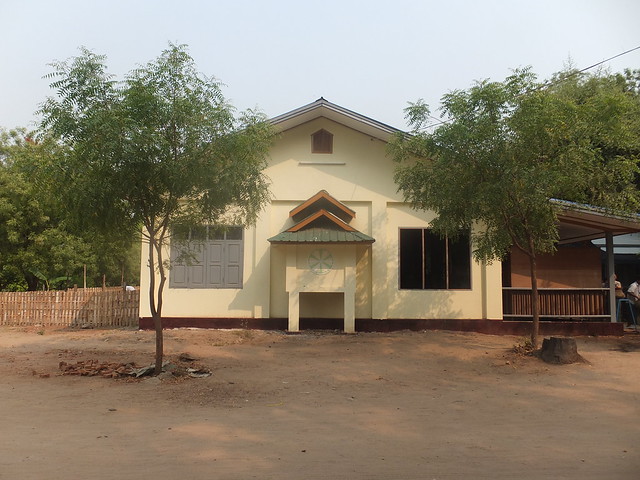 The New Clinic Building.
The New Clinic Building.
A Permanent Physiotherapy Unit, donated by a United Kingdom Travel Company and their clients, is currently being constructed.
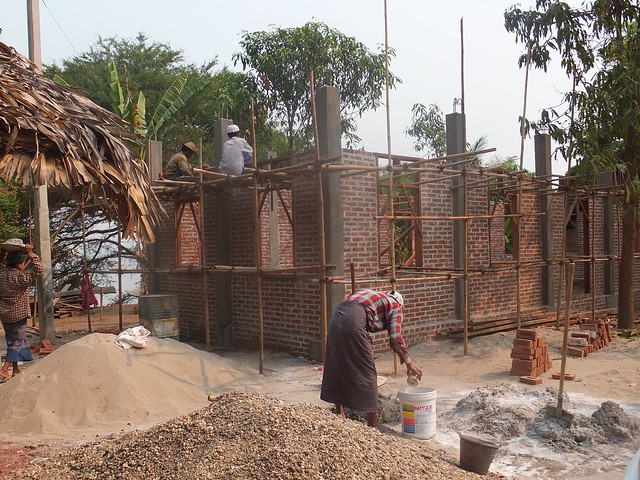 Builders at work on the new Physiotherapy Unit.
Builders at work on the new Physiotherapy Unit.
On Saturdays, a free lunch is prepared by the monastery and distributed to waiting patients.
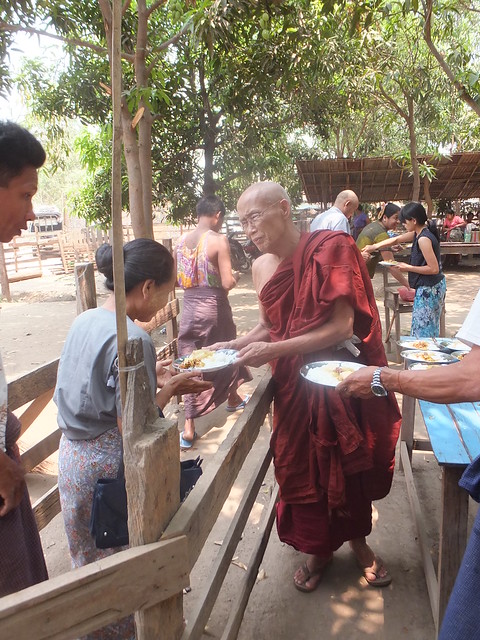
The Head Monk distributing free lunch to waiting patients.
Having taken plenty of pictures of the event, I said I'd walk back to my hotel and try to return when Dr. Hla Tun took his lunch at around two o'clock.
However, it was 42 degrees Celsius outside and by the time I'd arrived at my hotel, I was fit for nothing but resting, so I abandoned the idea of visiting the Doctor during his lunch. I knew that the Doctor normally took an evening meal in the Monastery about ten o'clock in the evening. I arrived back at the clinic around 9.30 p.m. when the Doctor was just breaking-off for food.
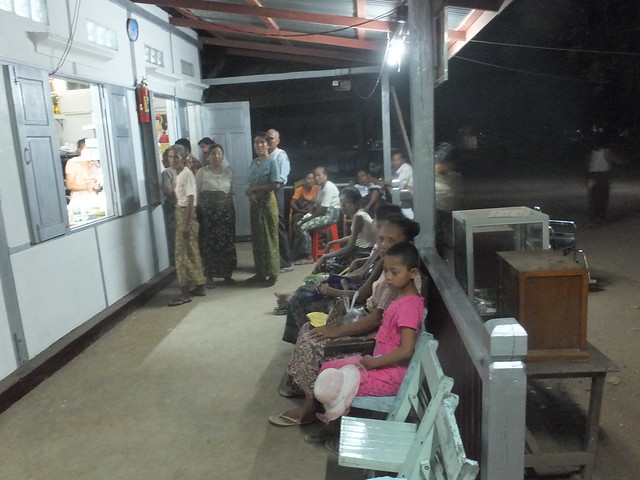 9.30 p.m. and now much quieter, but there are still patients waiting to be seen by a doctor.
9.30 p.m. and now much quieter, but there are still patients waiting to be seen by a doctor.
Doctor Hla Tun said he would then continue to work until about 11.30 p.m. to deal with the remaining 15 waiting patients but I'm afraid I left him to it and slowly made my way back to the Aye Yar Resort and bed.
My Pictures
Bagan Medical Clinic (My visit, April 2014).
Aye Yar River Resort, Bagan.
More
Next Post describing this trip.
All my posts on Medical Support in Burma.
[Revised 17-May-2014, 20-May-2014]
Events of Friday 25th April 2014
Click on any picture below for an uncropped image.
Although I’d slept a fair bit of the way back from Mawlamyine, the coach seats were really designed for a smaller, oriental frame. This, combined with a fairly intensive few days meant that I was not at my best when we disembarked in Yangon in the early morning.
Once back at Doctor Hla Tun's house, I managed a couple more hours sleep in the guest room before the Doctor took me to Yangon Central station. The Doctor knew of my interest in Myanmar Railways and he had kindly arranged for me to visit Yangon Central Signal Box to confirm what I'd previously written (Railway Signalling in Burma - Part 6: Signal Boxes with Electrical Interlocking). I spent a happy hour or so watching the complex moves around the station.
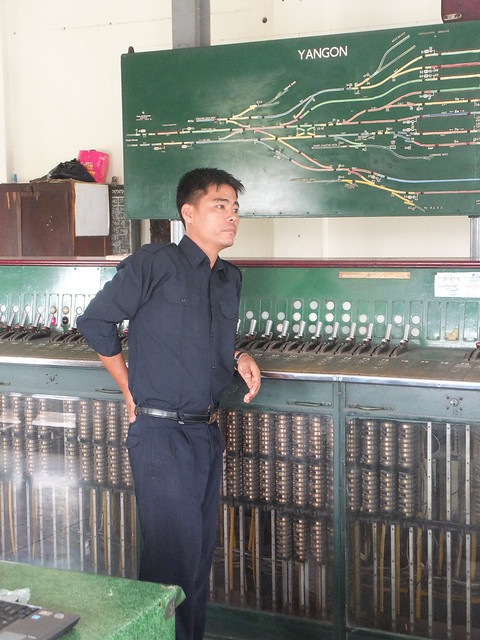
One of the young signalmen pauses by the power frame at Yangon Central Signal Box.
I could have easily spent longer here but the Station Master then casually offered a trip around the Circle Line, either on the train or in the locomotive cab. Perhaps you can guess my choice. I was invited to wait in the stationmaster's office whilst arrangements were made. I was to ride in the cab of the 13:00 clockwise Circle Line train, scheduled to complete the 32-mile round trip in 3 hours! I was conducted across to the waiting train and introduced to the friendly driver and his secondman. The locomotive was DF.1263, one of the Alstom Bo-Bo-Bo diesel electrics.
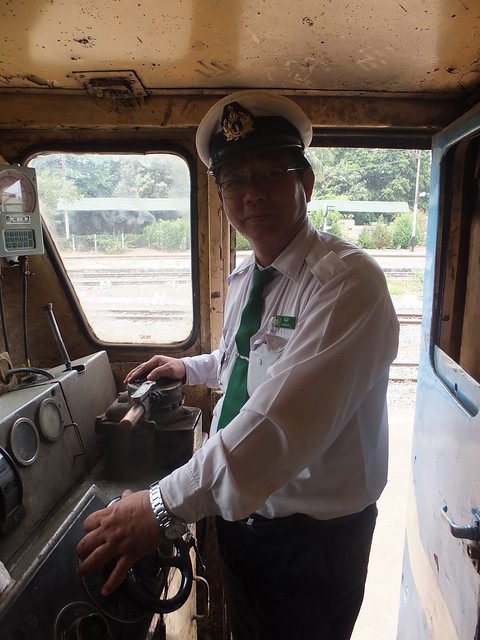 The friendly driver of DF.1263
The friendly driver of DF.1263
It had been my first trip on Yangon's Circle Line back in 2008 which got me interested in Burma's railways, so I welcomed the opportunity to repeat the trip from the vantage point of the locomotive cab.
My Pictures
Yangon Central Power Signal Box.
Cab Ride on the Circle Line, Yangon.
More
Next Post describing this trip.
Yangon Central Power Signal Box.
All my posts on Burma's Railways.
[Revised 17-May-2014]
Events of Thursday, 24th April 2014
Click on any picture below for an uncropped image.
After a second night sleeping on the floor of Ko Dut DIC, we shared breakfast with the volunteers. We said our 'goodbyes' to our friends at Ko Dut and embarked on a little sightseeing.
We drove to Thanbyuzayat which I'd first visited in 2012 (blog post here, supposedly named after the ‘tin shelter’ in the town centre which looks like a Victorian bandstand.
During the Second World War the area achieved notoriety because of the construction of the 'Death Railway'. To support the large Japanese Army which occupied Burma, the Japanese forced Commonwealth, Dutch and American prisoners of war to construct a metre gauge railway line over 400 km long connecting Siam (now Thailand) with the existing railway line through Thanbyuzayat. Work commenced late in 1942 and Thanbyuzayat became a Base Camp and Prisoner of War administration headquarters. In January 1943, a Hospital was added. Heavy prisoner casualties were also sustained during Allied bombing raids on the railway infrastructure in March and June 1943, resulting in prisoners and the sick being marched to dispersal camps along the new railway. Owing to the dreadful conditions, over 13,000 prisoners of war died during the construction, together with up to 100,000 conscripted or forced labourers from Malaya, Dutch East Indies, Siam and Burma. The railway was completed in December 1943.
After the War, graves were transferred to War Cemeteries in Chungkai and Kanchanaburi in Thailand and Thanbyuzayat in Burma. The remains of American prisoners were repatriated to the United States. We spent a few minutes at the War Cemetery at Thanbyuzayat, which has 3,149 Commonwealth and 621 Dutch graves maintained by the Commonwealth War Graves Commission. Their web page for this cemetery is here.
 Thanbyuzayat War Cemetery.
Thanbyuzayat War Cemetery.
Just south of the town, there's a commemorative plaque and a short length of track displaying what is claimed to be the first Japanese steam locomotive to run on the 'Death Railway'. In 2012, waterlogged ground made close inspection impractical but in 2014 I was able to study the rather battered locomotive. I was intrigued that bronze fittings had been replaced by wooden replicas, painted yellow.
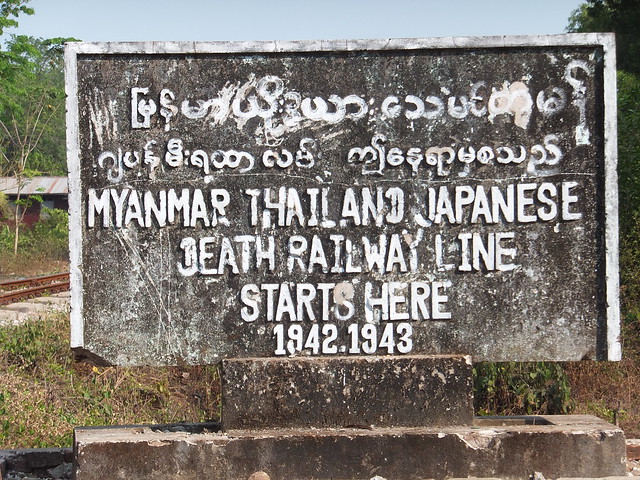 Plaque marking the end of the 'Death Railway'.
Plaque marking the end of the 'Death Railway'.
Next, we travelled west to Khaikhami Yele Paya temple built in the sea. On my earlier trip, construction of the concrete pier leading to the temples was being completed and the original wooden pier was still standing. By 2014 the old wooden pier had been removed. It was good to re-visit with the Doctor and his son.
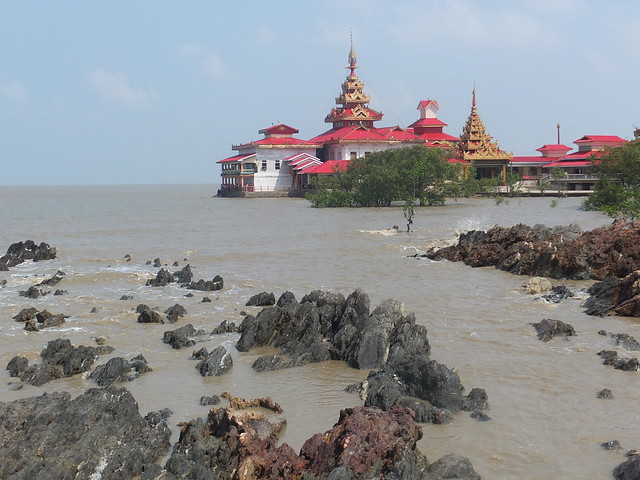 Khaikhami Yele Paya
Khaikhami Yele Paya
After visiting the temple, Doctor Hla Tun decided to purchase some fish to take back to Yangon. This involved some pretty serious discussion involving at least three of the stallholders and multiple weighings of the fish.
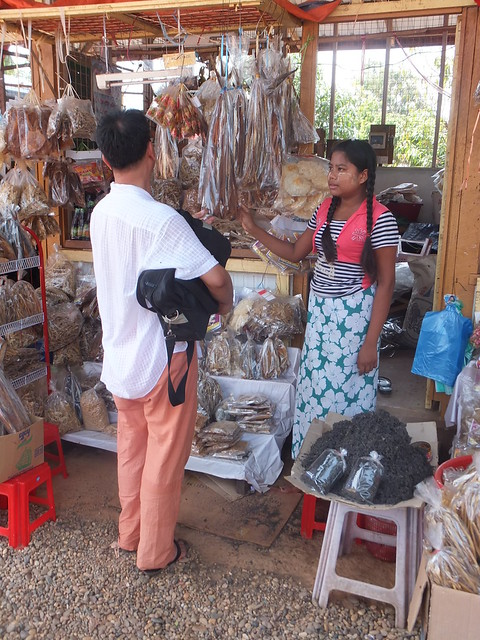
Purchasing fish.
Nearby, we visited an orphanage called 'Mirror Image' run by Sister Martha, a Catholic nun. Her English was excellent (she'd worked for 18 months in Moss Side, Manchester). Doctor Hla Tun donated medication. There were plaques crediting the assistance provided by the 'Grassroots Grant Assistance Scheme' in Japan and the Government of the Federal Republic of Germany. Three assistants were engaged in preparing monthly prescriptions of Anti Retroviral Treatment for issue to patients in their care.
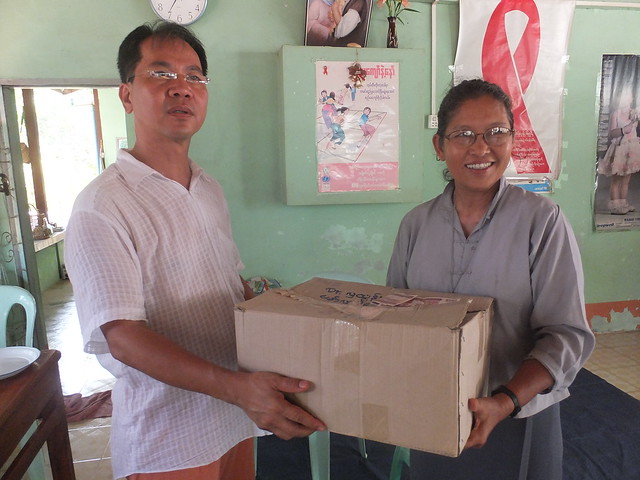 Doctor Hla Tun donates medication to Sister Martha at 'Mirror Image'.
Doctor Hla Tun donates medication to Sister Martha at 'Mirror Image'.
Finally, we detoured to the popular beach at Setse, where I was able to paddle in the Andaman Sea and enjoy fresh coconut milk with the Doctor and his Son. There were lots of people enjoying the beach but, this far from Yangon, traditional modesty prevails. A group of laughing young women running across the hot sand were dressed more for a Sunday School Outing than for the beach.
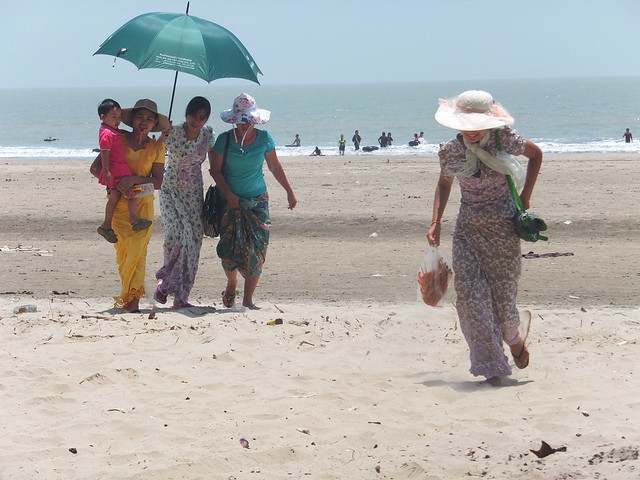 Setse Beach.
Setse Beach.
We made our way back north to Mawlamyine, pausing to buy fruit from a roadside stall. We visited two more DICs in the Mawlamyine area - Hlaing and 'Future Generation'. The population of Mawlamyine is around 300,000 and there are some decidedly poor areas.
At Hlaing, we were almost physically overwhelmed by around 400 youngsters (less than 300 had been expected). 'SKYNET' had a television cameraman and lady interviewer there and the Doctor recorded an improptu interview for them before we started the distribution. As before, there were some donations of financial assistance before the umbrellas and stationery were given out. The sheer numbers meant that the organisation did not always run smoothly but it all worked out, I think. Some rapid re-allocation had to be made of the stationery we had with us so that everybody received something on the day and the Doctor intended to send more items once he was back in Yangon.
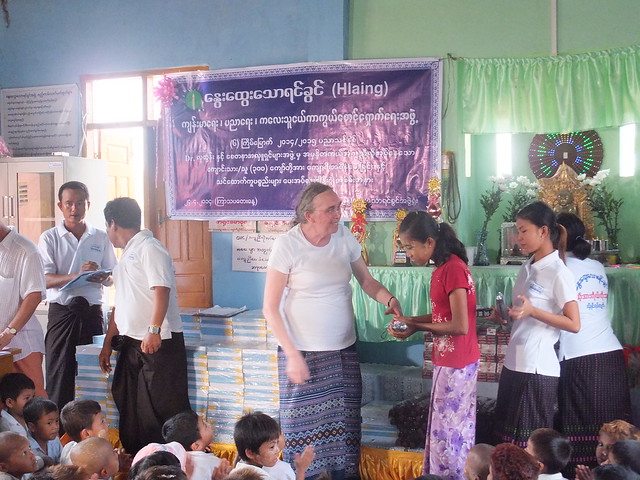 Distributions in progress at Hlaing.
Distributions in progress at Hlaing.
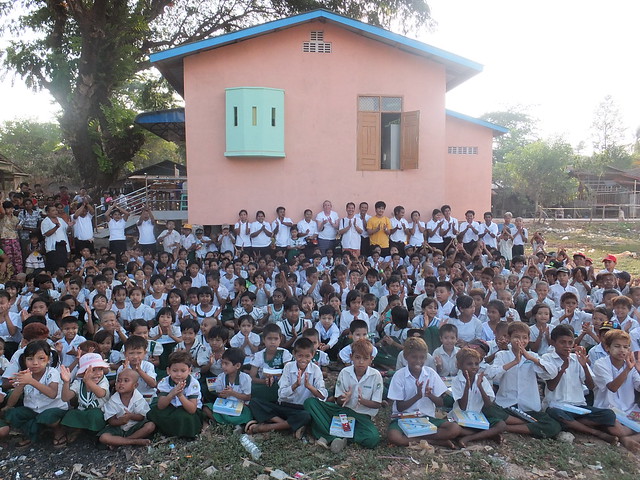 The 'Group Shot' at Hlaing.
The 'Group Shot' at Hlaing.
Our last distribution was at 'Future Generation' - a small DIC in a new building run by a charming lady. Both she and one of her assistants had computer science degrees. Once again, I was impressed by the commitment of all the volunteers who run these centres.
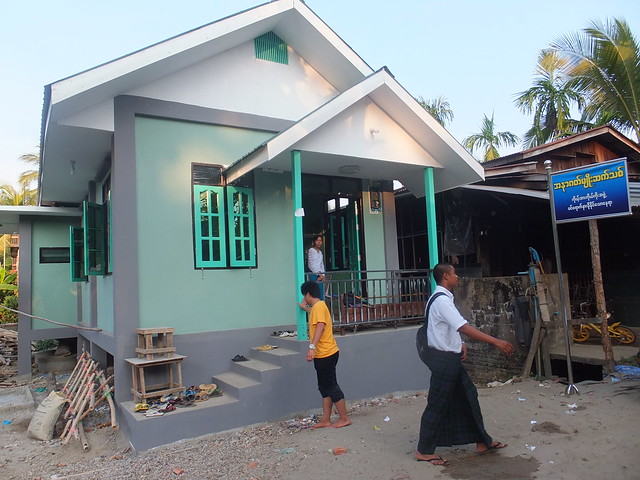 'Future Generation', Mawlamyine.
'Future Generation', Mawlamyine.
Our arrival was eagerly awaited by the young children who filled the D.I.C. and we soon completed the final distribution of our trip to Mon State.
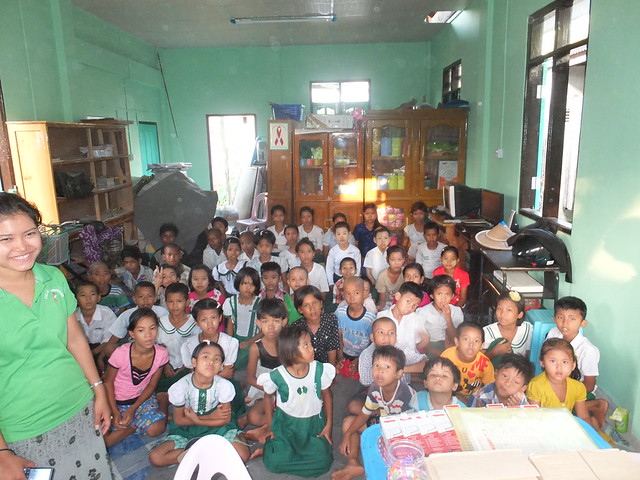 Young children eagerly awaiting the distribution at 'Future Generation'.
Young children eagerly awaiting the distribution at 'Future Generation'.
The children departed for the day and we chatted to the volunteers for a while before they, too, got ready to leave. By this time it was getting dark. We drove to the famous Strand at Mawlamyine which always takes on a holiday atmosphere at sunset. We strolled for a while amongst the happy crowds before driving to visit one of the famous hill-top temples. Finally, we drove to the P.T.T. Bus terminal in time to catch the 21:30 overnight bus to Yangon.
My Pictures
Thanbyuzayat area, Myanmar.
Khaikhami Yele Paya Shrine, Myanmar.
'Mirror Image' Orphanage.
Hlaing Drop In Centre, Mawlamyine.
'Future Generation' Drop In Centre, Mawlamyine.
Mawlamyine, Myanmar.
Mawlamyine - Yangon by Coach.
More
Next Post describing this trip.
[Revised 15-May-2014, 16-May-2014]
Events of Wednesday, 23rd April 2014
I woke at about 5.30 a.m. at Ko Dut D.I.C. to the curious sound of the first ox-cart of the day. On the earth roads, there was no sound from the hooves of the oxen but an unfamiliar clattering sound from the large, wobbly wheels as they turned on the axle. I think I'm getting a bit old for sleeping on the floor, dormitory style, so I was a bit fragile.
For breakfast, we were driven to the nearby home of one of the volunteers at Ko Dut D.I.C., a retired school mistress. As we left the D.I.C., there was already quite a large group of children gathered outside the D.I.C., waiting for the distribution to start. After an enjoyable breakfast (our hostess had made porridge especially for me), we drove back to the D.I.C., which was now full of excited children.
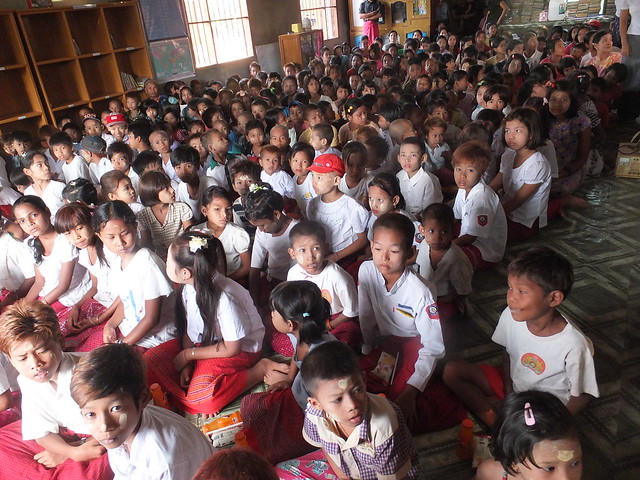 Children awaiting the distribution at Ko Dut D.I.C.(click on any picture for an uncropped view).
Children awaiting the distribution at Ko Dut D.I.C.(click on any picture for an uncropped view).
Even with the Doctor, his Son and Jan distributing the umbrellas and stationery, assisted by volunteers from the D.I.C., it took some time to complete the process.
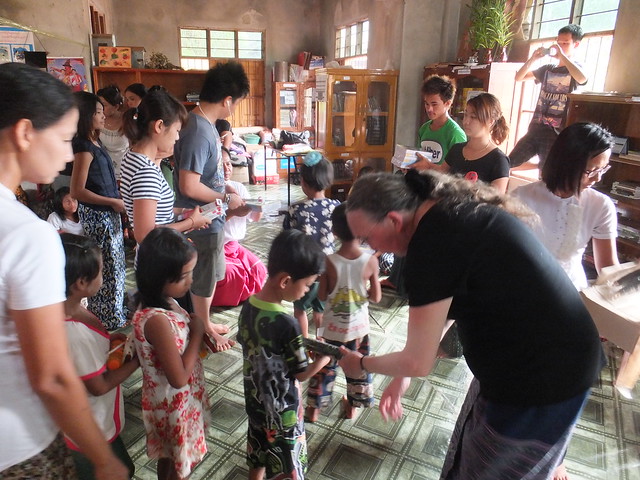 Distributing umbrellas and stationery at Ko Dut.
Distributing umbrellas and stationery at Ko Dut.
Then, we all re-grouped outside for the mandatory 'Group Shot'. In deference to the problems I'm now having squatting, I was provided with a moulded plastic stool.
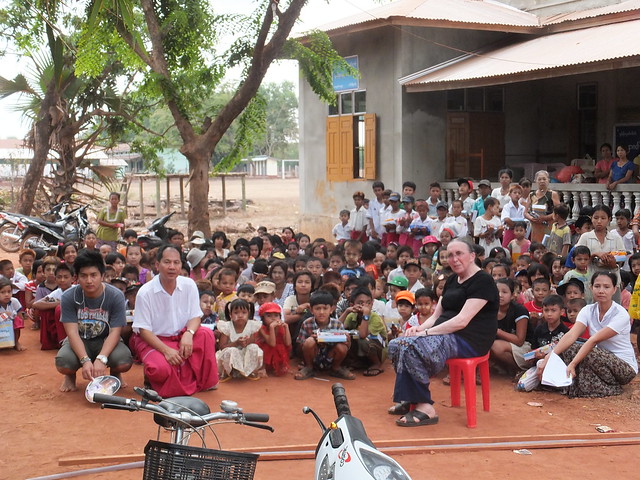 The 'Group Shot' at Ko Dut D.I.C.
The 'Group Shot' at Ko Dut D.I.C.
The work that the volunteers do in these D.I.Cs is impressive. I was delighted to discover that all the volunteers were to have a couple of hours off and have a meal at the beach with us. The volunteers divided themselves up between various motor cycles and our car set off in convoy with the light-hearted volunteers. After around fifteen minutes, we arrived at the beach, looking out across the Andaman Sea. We took over a beachfront cafe, famous for seafood and orders were placed. In view of my still-delicate digestion, I was circumspect about what I tried.
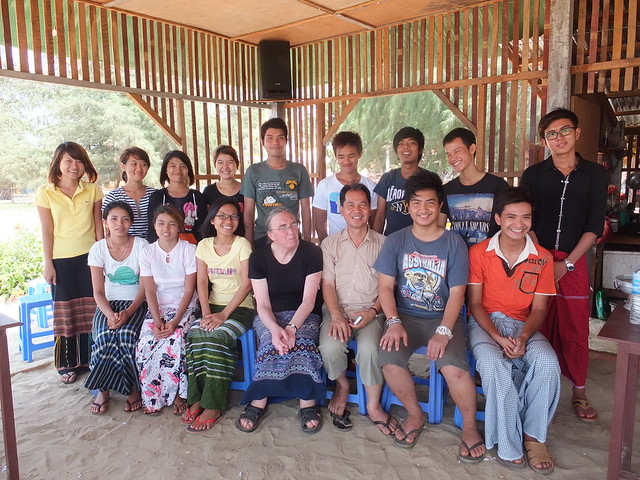 Ko Dut Volunteers at the Beach.
Ko Dut Volunteers at the Beach.
After this delightful interlude, the car took us to the two other Drop In Centres we'd arranged to visit. The first was La Mine D.I.C., around 7 km east of Ko Dut. This was a neat, modern building with a sign that read "Lamine Town Community Learning Center - LIBRARY" in English and Burmese. The centre seemed well-equipped with good quality tables, glass-fronted bookcases, plastic moulded chairs.
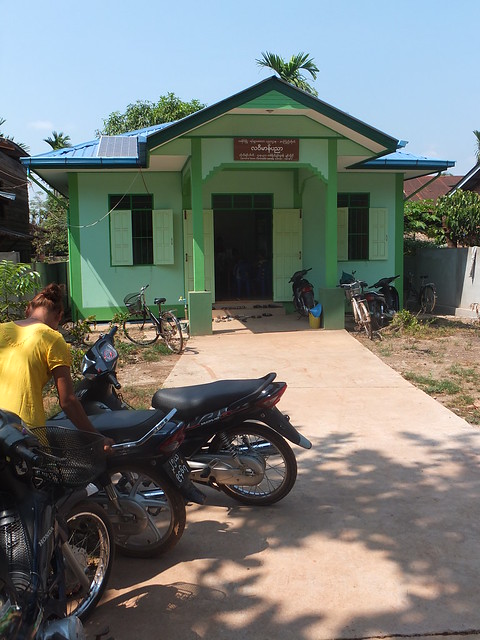 La Mine D.I.C.
La Mine D.I.C.
This multi-function centre again relies on volunteers for staffing. The commitment of these, mainly young, volunteers impressed me at each centre we visited. Where young pupils are being given financial support to help pay for schooling, the Doctor normally carried out an interview first. Then, we proceeded with the distribution of umbrellas and stationery to the grateful children.
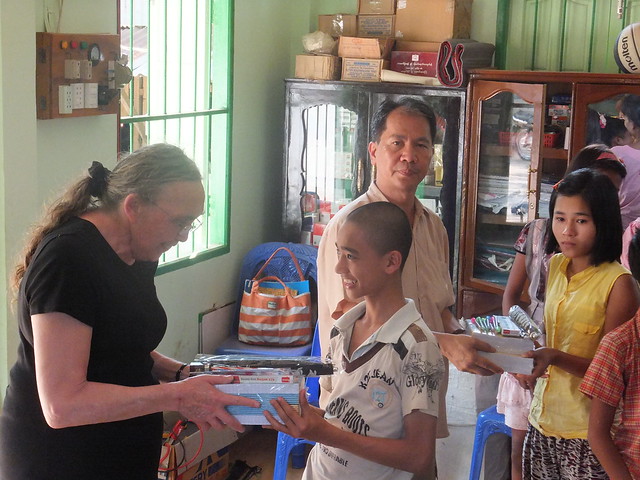 Distributing umbrellas and stationery at La Mine D.I.C.
Distributing umbrellas and stationery at La Mine D.I.C.
Then, we were off again to Mot Ka Nin, a further 3 km further east and situated on the main north-south road designated '8'. Equipment included glass-fronted bookcases, an exercise machine (!), an electronic keyboard, a treadle-operated sewing machine and a treadle-operated overlocking sewing machine (overlocking is explained in a Wikipedia article here. At this D.I.C., as usual, we distributed folding umbrellas and stationery.
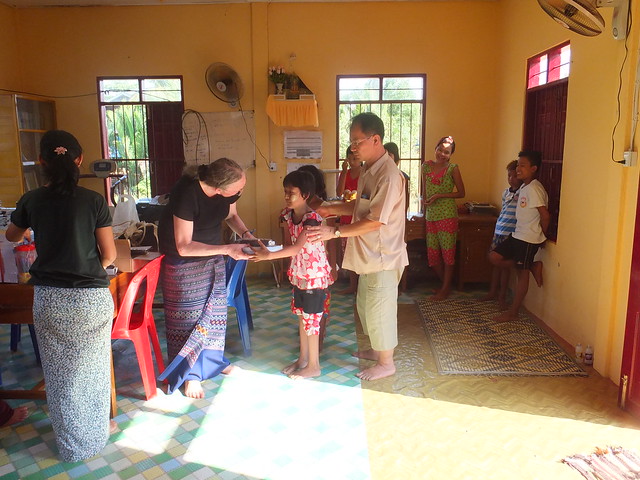 The distribution at Mot Ka Nin D.I.C.
The distribution at Mot Ka Nin D.I.C.
We started to make our way back towards Ko Dut. On the way, we paused to look at a new Monastic school being built. A monk was supervising a number of builders, some of whom were constructing a well adjacent to the school building.
Next, we looked at a small fishing village near the mouth of the Winyaw River. The single road ended abruptly at the waters edge and, on the opposite bank, the road could be seen continuing north. There was a vehicle ferry on the other side, but nothing was stirring until an electric machine started up nearby. It sounded like a wood-chipper but clearly wasn't. After a short while, I worked it out. A worker was feeding large chunks of ice into the machine which was producing crushed ice. This was used to fill large expanded polystyrene boxes into which the fish landed at the village would be packed for onward transmission. I spotted a sign relating to US AID-ASIA and IOM-OIM but I don't know what support was provided. US AID has a Bilateral-Mission in Burma and there's more on their website here, plus a 'Fact Sheet' here.
A few minutes drive from the fishing village took us to the Mon Ethnic Temporary School. Dr. Hla Tun visited this school during his visit to Mon State in 2013 (described in the post Orphans and Vulnerable Children Project in Myanmar. It was founded by a Monk, has five classrooms and is recognised by the government. We went to the site to see the progress on constructing a permanent school building. We found an impressive building on a difficult, sloping site.
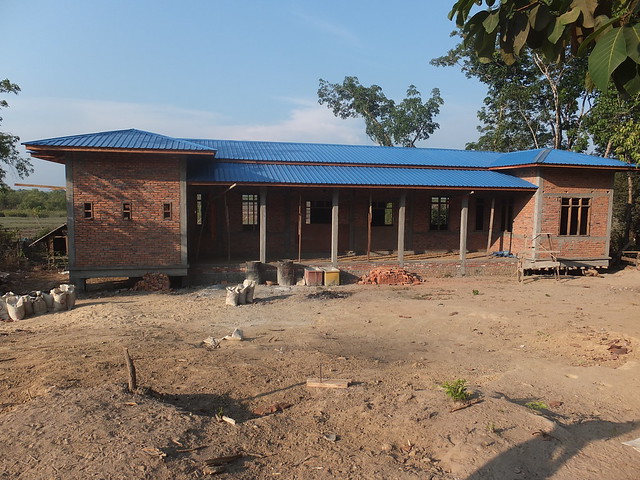 The Permanent Mon Ethnic School under construction,
The Permanent Mon Ethnic School under construction,
We had just one more stop to make - at a small orchard just outside Ko Dut. It has been planted with a tree which, after about seven years, produces a commercial crop used medicinally. The whole area has been provided with a network of irrigation pipes, fed from a concrete water tank in the middle of the site. A locked 'manhole' nearby puzzled me until it was unlocked to reveal secure storage for a portable petrol-engined pump. This is apparently used to re-fill the water tank, drawing water from a deep well near the orchard boundary. A rope-and-bucket is also provided so that water can be drawn manually (I tried this out myself). Whilst the petrol pump was filling the water tank, the two D.I.C. staff filled plastic watering cans and carefully checked the crop. It was a delightful tranquil few minutes.
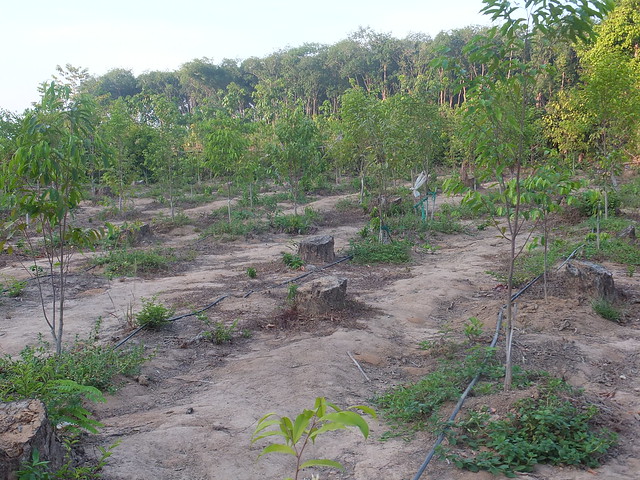 Orchard looked after by staff from Ko Dut D.I.C.
Orchard looked after by staff from Ko Dut D.I.C.
Then it was back to Ko Dut for a second night sleeping on the floor.
My Pictures
Ko Dut Drop In Centre.
La Mine Drop In Centre.
Mot Ka Nin Drop In Centre.
Around Ko Dut.
A Trip to the Sea.
More
Next Post describing this trip.
[Revised 14-May-2014, 15-May-2014]
Events of Tuesday 22nd April 2014
Click on any picture below for an uncropped image.
Only slightly revived by a couple of hours sleep at Mawlamyine, I prepared for our departure. We briefly met the Organiser's husband. He was a professional writer on archaeology and history and had just been discharged from hospital. He graciously gave me a copy of his latest work on Mon History.
It’s important to realise that early Burmese history was the history of a number of distinct ethnic groups who could be quite belligerent. Various kings attempted to unify the warring tribes and, when the British took over, they considered the problem solved which, of course, it wasn’t. The exploits of the Japanese in Burma during WWII probably did more to unify the various factions than any previous event. Mon National Day was created after the conclusion of WWII and, when the British granted independence in 1948, the Union of Myanmar specifically recognised the existence of these ethnic groups. For more information, try Wikipedia here.
Mon State, remote from the centre of the land mass, seems to suffer from the problem that in England is called “the North-South Divide”. It is, in general, poorer and in greater need of assistance. We were to visit the network of Drop In Centres (DICs) which are supported by Dr. Hla Tun.
First call was to the ‘Largest Reclining Buddha in the World’ which I’d visited before (there's a report here). There was a network of scaffolding around the head to facilitate maintenance. There’s a second, even larger, Buddha image being constructed on the other side of the valley – it hadn’t obviously changed a lot since my previous visit.
Then it was on to our first Drop-In Centre (DIC) at Kot Kha Pon, this one supported by aid from the Government of Australia and the Care International charity. The Doctor and his son distributed a folding umbrella and various items of stationery to the young people. The D.I.C. has a PC Computer and a treadle-operated sewing machine. A donation of cash was made to the volunteers whose time is essential to the running of the DICs.
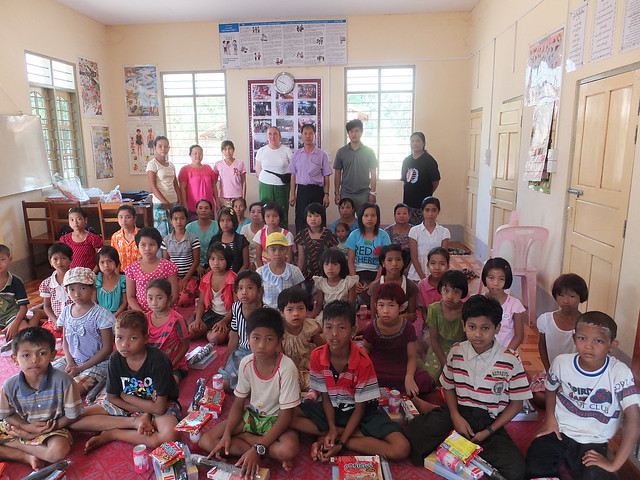 Kot Kha Pon Drop In Centre.
Kot Kha Pon Drop In Centre.
We then made our farewells and moved onto another DIC at Nyaung Kyo Mae. Again, there was a PC Computer and Sewing Machine. There was also a television set, I think arranged for playing videos. The Doctor made a donation of cash to students who are being assisted through Government Schools. Jan then assisted in distributing an umbrella and stationery to all the children.
 The distribution in progress at Nyaung Kyo Mae Drop In Centre.
The distribution in progress at Nyaung Kyo Mae Drop In Centre.
The next DIC was at Ka Mar Wet. All the umbrellas and stationery had already been selected into individual piles, ready for distribution.
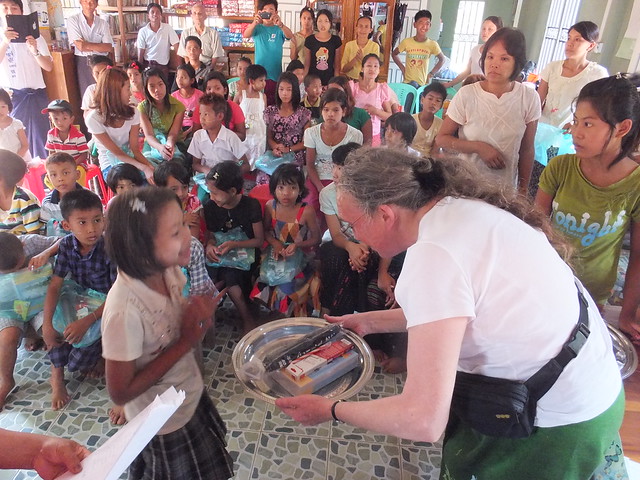 Jan assisting with the distribution at Ka Mar Wet.
Jan assisting with the distribution at Ka Mar Wet.
We then drove to Ko Dut, where we would sleep overnight in the DIC, prior to making distributions the following morning.
My Pictures
Kot Kha Pon Drop In Centre.
Nyaung Kyo Mae Drop In Centre.
Ka Mar Wet Drop In Centre.
Ko Dut Drop In Centre.
More
Next Post describing this trip.
[Revised 13-May-2014, pictures added 20-May-2014]
Events of Monday night/Tuesday morning 21st/22nd April 2014
Dr. Hla Tun had said he’s pick me up at 7.30 p.m. to go for dinner at his house. Because of my fragile state, I was reluctant to be too ambitious but I nibbled some food before the doctor, his son and I drove downtown to where our P.T.T. bus to Mawlamyine was due to leave at 9.00 p.m.
Apart from out personal luggage, we were taking various heavy cartons of some of the items to be distributed on our visits, which all had official ‘P.T.T.’ luggage labels attached.
 The Coach.
The Coach.
The coach seating was 2+1 and we had a complete row with the doctor and his son on the left of the aisle and me on the right. We set off a few minutes after nine and made fairly slow progress leaving the city. The sky was completely dark but the lights on the almost continuous chain of houses, shops and tea houses lining our route illuminated the apparently innocuous night life of the city.
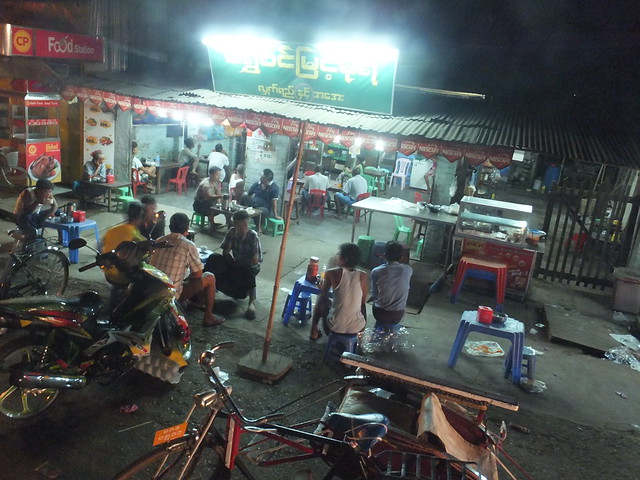 A Tea House on the road out of Yangon.
A Tea House on the road out of Yangon.
It was clear than we were following the road through Bago and Kyaikto to Mawlamyine, which I’d taken (in the opposite direction) returning from Mawlamyine on an earlier trip. Crossing a broad waterway, I looked immediately to my left and had a decent view of the Rolling Lift Bridge I’d commented on on my earlier trip (Bago to Kyaikto by Train).
After about four hours, we passed through Kyaikto and shortly the bus pulled into the car park of the large restaurant I’d seen on my earlier trip. At 1 o’clock in the morning, the place was thronged as there were already about four buses parked. My priority was a visit to the washroom then I had a cup of sweet tea with the Doctor and his Son, who were ready for more substantial food.
Our stop was less than half an hour and then we continued south. I think it was only around two hours later when we rumbled onto the long road and rail bridge which has transformed access to the south of Myanmar.
The bus took the main road through Mawlamyine furthest away from the sea and came to a stop at the brightly-lit bus office. We got off and retrieved our luggage, as did other passengers. By the time we were clear of the bus other passengers were boarding and, with a new driver, the bus departed but I didn’t find out the destination although I imagine it was further south.
We had a few minutes to wait in the oppressive heat of the night before the People Carrier which Dr. Hla Tun had arranged turned up. The we loaded everything aboard and set off inland towards to suburbs. The Doctor explained that the Orphans and Vulnerable Children (OVC) Project organiser for Mon State had offered to let us sleep at her house for a few hours until morning. However, our driver had trouble finding the address despite the Doctor phoning the lady and seeking “better and further particulars”. We eventually arrived when the lady walked from her house to the nearest junction, to direct our wandering People Carrier.
br>
The house was modern and brick built with the main room occupying the full width of the building approached from outside by a couple of steps (where footwear is discarded). There was a modern ceiling with a raised section featuring various electric light fittings and a polished parquet floor. A passage led towards the rear of the house, with partitioned sections left and right providing various bedrooms. This passage then opened out into a complex of kitchen, W.C. and Shower Room.
The intention had been to set out bedding (and mosquito nets) in the large main room for us all but they decided to set up two beds like this for the Doctor and his Son, giving me one of the bedrooms which I think involved turfing one of the daughters out of her room in the middle of the night. There was a simple raised bed with a mosquito net and the top of the small storage unit certainly contained a girl’s beauty products, including a large disk for Thanaka grinding. Thanaka is the white cream still applied by most girls and young boys intended as a sunscreen and beautifier. Personally, I find it rather astringent and uncomfortable.
I quickly collapsed into the bed but I only had a couple of hours before it was time to set off further south by car – Mawlamyine was only a ‘staging post’ to the parts of Mon State we were to visit, accompanied by the OVC Organiser.
This was to be my first visit to see for myself the work of the OVC Project, but there are earlier reports on the visits made by Dr. Hla Tun in 2013 here and in 2012 here.
My pictures
Mawlamyine - Yangon by Coach.
Rest Stop at Mawlamyine.
More
Next Post describing this trip.
Events of Monday, 21st April, 2014
My A319 landed at Mingalardon Airport (Yangon) at 05:55 in the morning and taxied to the International Terminal. The air bridge was quickly attached and the Business cabin quickly emptied into the almost-empty terminal. Immigration was the first stop and two queues had formed ('Myanmar' and 'Foreigners') well before before the immigration officers took up their posts. By the time I got to Baggage Reclaim, all the Business Class luggage (usually first off) was lined up on the floor. All baggage was X-rayed on the way out but, having handed over the customs declaration, I was in the arrivals hall at 06:15 - the published arrival time.
After a few minutes,Doctor Hla Tun arrived by car, accompanied by his son, to collect me. We drove towards the city and the Doctor thought I should be given breakfast. We stopped at an already-busy Indian-style restaurant with hordes of waiters in numbered blue T-shirts who shouted their orders at the top of their voices. I was O.K. with the Naan bread and Steamed Rice but I was encouraged to try some simple vegetarian fare which, unfortunately, overwhelmed my delicate digestion resulting in a bout of sickness later.
The Doctor had booked a day room for me at the Winner Inn, a hotel just a short distance from his house.
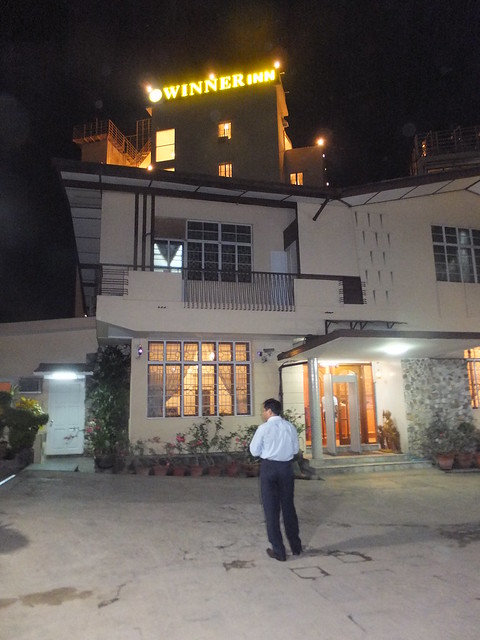 The Winner Inn, Yangon.
The Winner Inn, Yangon.
I spent the morning lying on my bed (feeling sorry for myself) before being collected at noon by the Doctor for lunch at his home where I met his wife again and, for the first time, his mother-in-law. I'm afraid I didn't do justice to the splendid meal provided. Having dosed me for my indigestion, the Doctor returned me to my hotel, suggesting a quiet afternoon. He said he would return around 7.30 p.m. to collect me for dinner before we set off for Mon State by overnight coach.
More
Next post describing this trip.
Sunday evening, 20th April 2014
It's 20:45 in Qatar (two hours ahead of England) and I'm in the large Business Lounge after a good flight by A330 from Manchester. I've just had time for a quick shower before making my way to the gate for the connecting flight to Yangon. So far, very good. Well, I went to the Gate as requested and they apologised, saying boarding would be delayed 20 minutes, so I came back to the lounge. There are lots of uniformed Qatar Airways girls around the terminal (plus plenty of sober-suited men). All the girls are very friendly, without being gushing (Britsh Airways please copy).
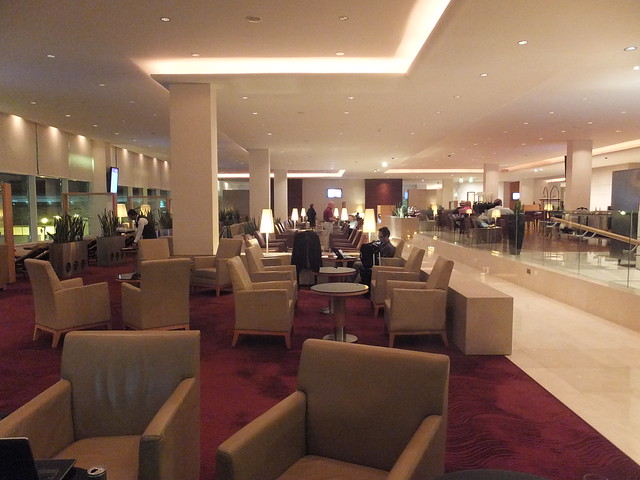 The Qatar Airways Business Lounge at Doha Airport.
The Qatar Airways Business Lounge at Doha Airport.
I was very impressed with the flight from Manchester to Qatar. The A330 cabin was very clean and inviting and the business class section at the front was only partly loaded, all making the flight more enjoyable. The crew were very helpful and attentive without being intrusive.
The entertainment system was lots of channels on demand and plenty of new releases. Not quite state-of-the-art so the picture quality wasn't brilliant with slight patterning but eminently watchable. Flights are the only time I see modern films before they appear on television, so I watched 'Gravity' (quite impressed) and 'Alpha Papa' (produced only the occasional titter).
More
Next post describing this trip.
Events of Sunday, 20th April 2014
Another adventure starts! Alan picked me up from home at 6.00 a.m. and we had a speedy journey to Terminal 2 at Manchester. This time, I'm flying Qatar Airways to Doha where I change for a flight straight to Yangon. This avoids the irritation of flying to Bangkok (overflying Burma in the process) and then having to take another flight back to Yangon. It's my first time with Qatar Airways so we'll see how I get on.
It's a while since I flew from Manchester and, at first sight, the terminal building seemed a bit daunting. A bit of a walk took me to the Qatar Airways check-in desks where a friendly Lancashire girl quickly completed the formalities. With just one carry-on shopping bag (including my trusty Fujitsu notebook computer) I made my way upstairs and more walking took me to the security area.
There are a number of 'Rapiscan' baggage scanners - each associated with an elaborate conveyor system for transferring the plastic boxes for items of luggage through the X-ray machine and then, once emptied, returning them to the loading point. Body scanning was by the normal 'portal' scanner, accompanied by smiles from the staff.
More walking took me to the glitzy Duty Free and retail area. I picked up my Sunday newspaper from W.H. Smiths. Nothing as prosaic as a normal sales till here - just a row of computer screens each associated with a scanner to check both the purchase and the Boarding Pass. Fortunately, two young members of staff, a boy and a girl, were in attendance. The process didn't seem that simple when the girl rapidly processed my newspaper - I shudder to think how long it would have taken me unaided. I don't think I'm really cut out for this automated age.
Duty Free (seemingly reluctantly) disgorged me to the departure gates area. I managed to find the signs leading to the 'Escape Lounge' (appropriate name) which, amongst other airlines, handles Qatar Airways. Real people here and, again, friendly. I started to relax a little.
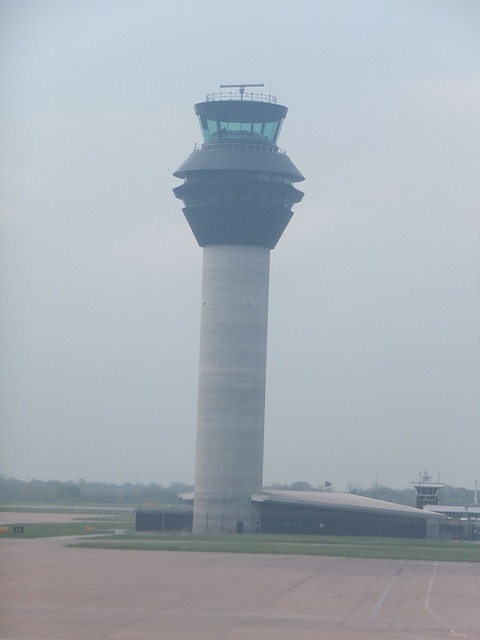 Manchester Airport Control Tower (the camera's leaning, not the Control Tower).
Manchester Airport Control Tower (the camera's leaning, not the Control Tower).
My Pictures
Manchester Airport
More
Next post describing this trip.
When I was young, I was an avid reader of model railway magazines. A recurrent theme was 'minimum space layouts', aiming to convince the reader that, wherever they lived, they had room for a model railway layout. Some layouts were arranged to form part of, say, a bookcase, so that they could be on display in a sitting room. Others were arranged to hinge upwards so as to be parallel to a wall when not in use. A fairly drastic approach was the layout suspended on cables from the ceiling and carefully counterbalanced, allowing the whole layout to be raised to the ceiling once the operating session had ended.
But, back then, I didn't see advocated the rather startling solution adopted by the model railway shown in my picture.
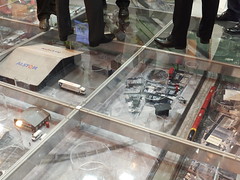
A 'computer floor' has been fitted in the model railway area. These are often provided in offices where a 'false floor' is provided by a grid of square frames suspended on pillars a few inches above the real floor, invariably concrete in modern buildings. Each pillar is provided with some height adjustment to compensate for the real floor being not quite flat. Each rectangular frame is then fitted with a substantial 'tile'. The space below the tiles then gives an unemcumbered space to lay cables.
But this modeller has decided that the technique which provides space for cabling in offices would be better used for a 4mm scale model railway, complete with scenery! All that's needed is clear tiles so that you can see the railway beneath your feet. It looks as if clear polycarbonate material has been used for the 'false floor'. Presumably to provide extra support, a number of lengths of clear tube (a similar length to the supporting pillars) have been dotted around.
Considering how innovative the technique adopted for providing space for the railway is, the track layout is rather unimaginative - a large double-track oval with a couple of modern trains both running clockwise (probably a Class 323 and a rather short 'Pendolino set).
Will this solution catch on, I wonder? Well, I doubt it. Construction must be rather expensive and the arrangement is not ideal for dealing with derailments or re-marshalling of trains.
Actually, this model was an eye-catching publicity stunt on the Alstom stand at the 2012 'Infrarail' exhibition at Earl's Court.
My pictures of the Alstom Model Railway
Model Railways
Introduction
In the 19th century, Myanmar, then known as Burma, was administered as part of 'British India'. The British built the extensive metre gauge railway network so it’s not surprising that the system largely followed British and Indian practice.
On my first trip to Burma in 2008, I travelled on the Circle Line in Yangon (see my post The Circle Line, Yangon) and that got me hooked on railways in Burma. During the long period of military rule in Burma, the railways have been cut-off from British influence, leading to interesting (and sometimes odd) consequences. Part of my fascination with the railways in Burma is that there doesn't seem to be too much information readily available to assist the study. My trips to Myanmar are not principally railway holidays, but I do take any opportunity presented to find out more. On each visit, I try to collect a little more information.
The Myanmar Railways Shield appears on each seat cover in this Upper Class coach.
Control
Railways in Myanmar are controlled by the Ministry of Rail Transportation. There is a website here but most of the site is in Burmese.
Although a lot of the system is decrepit through lack of maintenance, Myanmar is now engaged in a programme of doubling some of the single-line sections and constructing new railways so the maps below may not be up-to-date.
Plinthed steam locomotive outside the Ministry of Rail Transportation in Naypyidaw.
Railway Maps
The maps below show how the railways in Myanmar are divided into 11 Divisions. These maps originally appeared on the official Ministry site but they can also be found in the Wikipedia article List of railway stations in Burma. On these maps, only a few main stations show their name in English but the Wikipedia article also lists the names of all stations (and their mileages) in English. Clicking on any of the maps below will show a larger version.
Key Map
Myitkyina (Division 1)
I've twice made round trips on a 'Road to Mandalay' private train between Katha and Naba within the Myitkyina Division. The first trip was in 2010 (described in posts here and here). The second trip was on the 18th September 2012 and is briefly described here. Each of the posts has links to photgraphs.
Ywa Htaung (Division 2))
My first visit to Ywa Taung was in 2012 when I visited by road with Doctor Hla Tun. I became quite excited studying the 'Trapped Key' interlocking provided on points, described in the post Manual Control of Points and Interlocking. My second vist was in 2013, again by road. There's a set of pictures here.
Mandalay (Division 3)
There's a brief post about the Mandalay area here and this post links to photographs. On 23rd March 2013 I travelled from Mandalay to Maymyo by train, described in a post here.
Kalaw (Division 4)
Taungoo (Division 5)
Yangon (Division 6)
In 2012 I travelled from Yangon Central to Bago and Kyaikto (described here and here).
Yangon Central(Division 7)
My first trip on the Circle Line in 2008 is described here. In 2012 I travelled on part of the Circle Line from Yangon Central to Mahlwagon on the way to Bago and Kyaikto (described here) and later in the same trip I made a journey as far as Pa Ywet Seit Gone then back to Yangon Central (described here). In 2013 I travelled from Yangon Central to Da Nyn Gone and back and from Pazundaung to Yangon Central.
There's a general description of the railways around Yangon here.
Mawlamyine (Division 8)
Hinthada (Division 9)
Pakokku (Division 10)
Bagan (Division 11)
Railway Rolling Stock in Burma
Freight Rolling Stock in Burma
Passenger Rolling Stock in Burma
Diesel Railcars in Burma
(Other topics in preparation).
Railway Signalling in Burma
There's a series of posts about the signalling of the railways:-
Part 1: Semaphore Signals
Part 2: Colour Light Signals & Motor Points
Part 3: Control of Trains
Part 4: Manual Control of Points and Interlocking
Part 5: Signal Boxes with Interlocking Frames
Part 6: Signal Boxes with Electrical Interlocking
(Other topics in preparation).
Related articles on other sites
The Man in Seat 61
(Covers rail travel all over the world) and the best source I've found describing the actual business of using trains in Myanmar).
Myanmar Railways (Wikipedia).
Mike's Railway History
(Includes a brief description of Burma's railways in the 1930s. I believe much of the information was derived from 'Railway Magazine' or a similar technical publication. I found the same text and photographs appear as a PDF on the Old Martinians' Association U.K. Website. This article, by Peter R. Moore, includes additional material and a number of more modern photographs showing steam locomotives at work in Burma).
My Pictures
All my railway pictures in Burma form a Collection Railways in Burma.
This report is based on information from Doctor Hla Tun, who also supplied the photographs.
The Bagan Clinic made 2,265 treatments in March 2014, bringing the total number of treatments since the Clinic opened about two and a half years ago to 100,203.
Treatment Summary
The table below summarises the number of treatments per month in 2013/2014 and the total number of treatments since the clinic opened on August 6, 2011.
| Month |
Treatments in month |
Total treatments |
| February 2013 |
2,713 |
49,850 |
| March 2013 |
2,713 |
49,850 |
| April 2013 |
2,061 |
54,924 |
| May 2013 |
3,303 |
58,227 |
| June 2013 |
5,586 |
63,813 |
| July 2013 |
6,079 |
69,892 |
| August 2013 |
5,337 |
75,229 |
| September 2013 |
4,826 |
80,055 |
| October 2013 |
3,647 |
83,702 |
| November 2013 |
4,465 |
88,167 |
| December 2013 |
3,387 |
91,554 |
| January 2014 |
3,501 |
95,057 |
| February 2014 |
2,881 |
97,938 |
| March 2014 |
2,265 |
100,203 |
Monthly notes
In March, the temperature in Bagan is around 40 to 42 degree Celsius and fewer patients attend. Most patients have to travel significant distances to reach the clinic and the heat makes travelling more uncomfortable.
An 81-year old lady had travelled 55km from her village to the clinic. A week before, she suffered a fracture of the neck of her left femur. She needed assistance both medically and financially. A donation was made for further management in the Hospital.
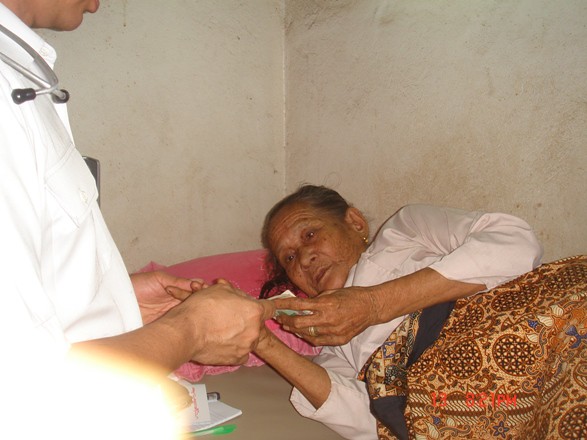 An 81-year old lady with a fractured femur.
An 81-year old lady with a fractured femur.
In January, a 12-year old boy suffering from mucopolysacchroidosis was brought to the Clinic by his mother. According to his mother, he could speak until he was 5-years old but the condition became worse and he has been unable to speak since he was 6-years old. A donation was made to assist with an investigation at the hospital in Mandalay and a local Non-Governmental Organisation (NGO) was suggested for additional help. After a CT-scan a diagnosis of mucopolysacchroidosis with ventricular enlargement was made. The neurosurgeon suggested surgery to improve the ventricular problem. The NGO has provided 50% of the cost of surgery and the Bagan Clinic has donated 25% of the cost.
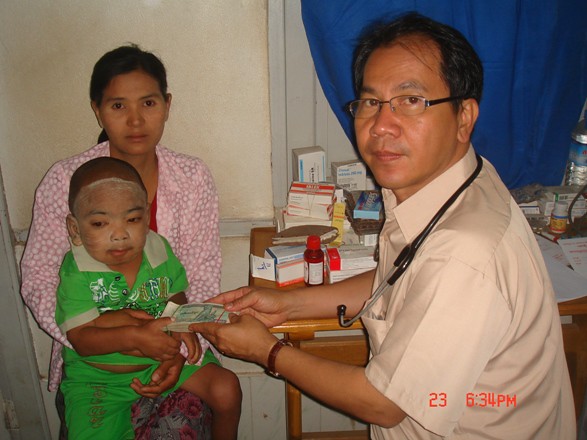 12-year old boy suffering from mucopolysacchroidosis.
12-year old boy suffering from mucopolysacchroidosis.
On the 'Clinic Days' Friday and Saturday, a free lunch is served to patients and their companions. Between 250 and 400 meals are served each day.
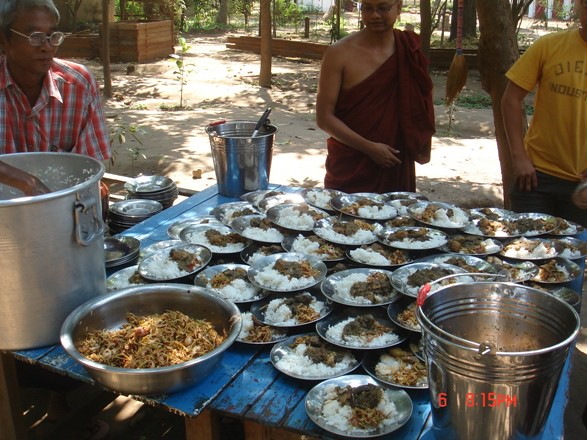 Free lunches being prepared at the Bagan Clinic.
Free lunches being prepared at the Bagan Clinic.
There are a number of posts in this Blog on medical support in Myanmar provided by the RTM Social Contribution with help from donors around the world. You can find them all here.
Doctor Hla Tun's photographs showing the work of the Bagan Clinic in 2014 are here. There's a larger collection of pictures showing the Bagan Clinic from its inception here.
 The original Clinic Building, formally opened on 30th October 2011, remains in use for consultations and dispensing medication.
The original Clinic Building, formally opened on 30th October 2011, remains in use for consultations and dispensing medication.
 The New Clinic Building.
The New Clinic Building.
 Builders at work on the new Physiotherapy Unit.
Builders at work on the new Physiotherapy Unit.

 9.30 p.m. and now much quieter, but there are still patients waiting to be seen by a doctor.
9.30 p.m. and now much quieter, but there are still patients waiting to be seen by a doctor.






























